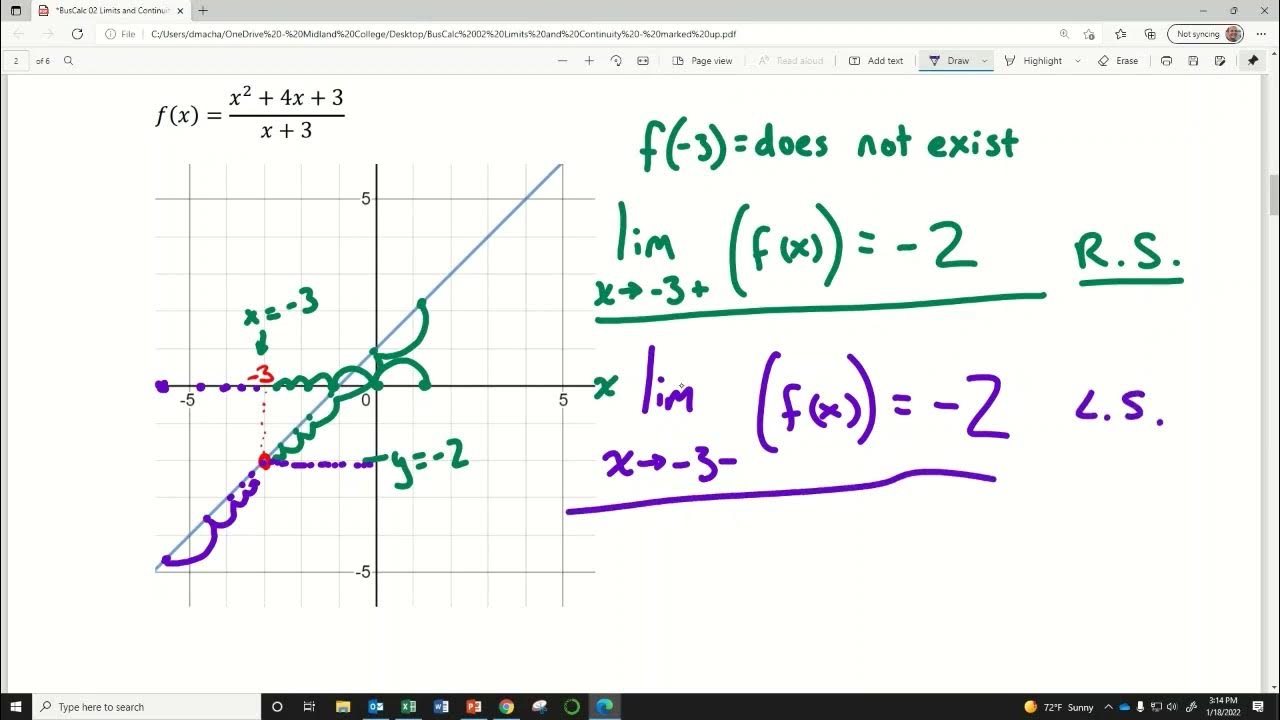Three Types of Discontinuities in Functions
TLDRThe video script discusses the three main types of discontinuities in functions: removable, jump, and infinite discontinuities. Removable discontinuities, often visualized as holes in the graph, occur when the limit exists and is finite but not equal to the function's value at that point. Jump discontinuities are characterized by the function's left and right limits being different constants, creating a 'jump' between them. Infinite discontinuities, synonymous with vertical asymptotes, happen when the function's limit approaches infinity as it approaches a certain point. The script provides algebraic examples and emphasizes the importance of understanding limits in identifying these discontinuities, which is crucial for AP Calculus students.
Takeaways
- 📊 There are three types of discontinuities in functions: removable, jump, and infinite discontinuities.
- 🕳️ Removable discontinuities, also known as holes, occur when the limit exists and is finite but not equal to the function's value at that point.
- 🔢 For a removable discontinuity, the function's value at the point may not exist, or it could be different from the limit as x approaches that point.
- ⏏️ Infinite discontinuities, or vertical asymptotes, happen when the function's value approaches infinity or negative infinity as x approaches a certain point.
- 🚫 A jump discontinuity is characterized by the left and right limits approaching different finite values, resulting in a 'jump' in the graph.
- 🔍 To identify discontinuities, look for factors in the denominator that do not cancel out with factors in the numerator.
- 📉 A function with a removable discontinuity can be simplified by canceling out common factors, revealing the discontinuity.
- 🔁 For jump discontinuities, evaluate the left and right limits separately to determine if they are equal; if not, a jump exists.
- 📍 The absolute value function, f(x) = |x|/x, is a classic example of a function with a jump discontinuity at x = 0.
- ∞ When dealing with infinite discontinuities, look for one-sided limits (from the left or right) that approach positive or negative infinity.
- 📌 Even piecewise functions can have discontinuities, and it's important to evaluate the limits from the left and right at the points of transition.
Q & A
What are the three types of discontinuities in functions?
-The three types of discontinuities in functions are removable, jump, and infinite discontinuities.
How are removable discontinuities represented on a graph?
-Removable discontinuities are represented as holes in the graph, where the function approaches the same point from the left and right but does not exist at that point.
What are the conditions for a function to have a removable discontinuity?
-A function has a removable discontinuity if the limit as X approaches C of f(X) exists and is finite, the limit from the left equals the limit from the right, and f(C) is not equal to the limit as X approaches C of f(X).
How is a jump discontinuity graphically represented?
-A jump discontinuity is graphically represented by a sudden 'jump' from one value to another without reaching the intermediate values, appearing as a gap in the graph.
What is the condition for a function to have a jump discontinuity?
-A function has a jump discontinuity if the limit as X approaches C from the left of f(X) is not equal to the limit as X approaches C from the right of f(X), and both limits exist and are finite.
What is another name for infinite discontinuities?
-Infinite discontinuities are more commonly known as vertical asymptotes.
How are vertical asymptotes represented on a graph?
-Vertical asymptotes are represented on a graph as a vertical line that the function approaches but never reaches, often resulting in the function going to positive or negative infinity.
What is a characteristic of a function that has an infinite discontinuity at a certain point?
-A function has an infinite discontinuity at a certain point if the limit as X approaches that point from the left or right is positive or negative infinity.
What is a common algebraic scenario that leads to a removable discontinuity?
-A common algebraic scenario that leads to a removable discontinuity is when a factor in the denominator that is zero also appears in the numerator to the same degree, but does not completely cancel out.
What is a famous function that has a jump discontinuity?
-The function f(x) = |x|/x is a famous function that has a jump discontinuity at x = 0.
How can you identify a vertical asymptote in a rational function?
-You can identify a vertical asymptote in a rational function by looking for a zero in the denominator that does not cancel out with a factor in the numerator.
Why might a piecewise function have a weird scenario for a vertical asymptote?
-A piecewise function might have a weird scenario for a vertical asymptote because the function's definition changes at certain points, leading to different behaviors of the limits from the left and right.
Outlines
📊 Types of Discontinuities in Functions
This paragraph introduces the three main types of discontinuities in functions: removable, jump, and infinite discontinuities. Removable discontinuities, also known as holes, occur when the limit exists and is finite but not equal to the function's value at that point. The paragraph provides a graphical representation and algebraic examples, such as the function f(x) = (x + 3)(x - 4) / (x + 3), which simplifies to x - 4 with the restriction that x cannot be -3, thus creating a removable discontinuity at x = -3. The concept of limits from the left and right is emphasized as a key factor in identifying these discontinuities.
🚀 Jump Discontinuities and Their Characteristics
The second paragraph delves into jump discontinuities, which are characterized by a sudden 'jump' in the function's value. Graphically, this appears as a gap where the function does not reach a certain value. The limits from the left and right as x approaches the point of discontinuity are finite but not equal, which is the defining feature of a jump discontinuity. A well-known example given is the absolute value function f(x) = |x| / x, which has a jump discontinuity at x = 0. The paragraph also discusses how to identify jump discontinuities algebraically, by looking at piecewise functions and evaluating the left and right limits.
∞ Infinite Discontinuities and Vertical Asymptotes
The final paragraph discusses infinite discontinuities, more commonly known as vertical asymptotes. These occur when the function's value approaches infinity as x approaches a certain point, or when the function 'crashes' into a vertical line. The definition of a vertical asymptote involves one-sided limits, and it is sufficient for either the limit from the left or the right to be infinite. Examples include rational functions where the denominator equals zero and does not cancel out with the numerator, such as 5x^2 / (x - 4), which has a vertical asymptote at x = 4. The paragraph also touches on piecewise functions and how to identify vertical asymptotes in such cases.
Mindmap
Keywords
💡Discontinuities
💡Removable Discontinuities
💡Jump Discontinuities
💡Infinite Discontinuities
💡Vertical Asymptotes
💡Limits
💡Piecewise Functions
💡Rational Functions
💡Continuity
💡Algebraic Functions
💡One-Sided Limits
Highlights
There are three types of discontinuities in functions: removable, jump, and infinite discontinuities.
Removable discontinuities, also known as holes, occur when the limit exists and is finite but not equal to the function's value at that point.
Jump discontinuities are characterized by the left and right limits existing and being finite, but not equal to each other.
Infinite discontinuities, or vertical asymptotes, occur when the function approaches infinity as it approaches a certain point.
The function f(x) = (x + 3)(x - 4) / (x + 3) has a removable discontinuity at x = -3.
Piecewise functions can have removable discontinuities if the limits from the left and right are equal and finite but not equal to the function's value.
The absolute value function, f(x) = |x|/x, is a famous example of a function with a jump discontinuity at x = 0.
For jump discontinuities, the function must approach different values from the left and right, indicating a 'jump' in the graph.
Vertical asymptotes can occur in piecewise functions and are identified by one-sided limits approaching infinity.
A function has an infinite discontinuity when it attempts to divide by zero, leading to an undefined expression.
The limit from the left or right of a function at a point determines the presence of a vertical asymptote.
Removable discontinuities are identified by factors in the numerator and denominator that cancel out, leaving a defined expression.
The function f(x) = 2x + 7 for x ≤ 2 and f(x) = x^2 + 8 for x > 2 has a jump discontinuity at x = 2.
Zeroes in the denominator of a rational function that do not cancel out completely result in vertical asymptotes.
Understanding the behavior of limits is crucial for identifying the type of discontinuity a function has.
The video provides examples and explanations for identifying and understanding different types of discontinuities, which is valuable for AP Calculus students.
The concept of limits is central to determining whether a discontinuity is removable, a jump, or infinite.
Transcripts
Browse More Related Video

Types of discontinuities | Limits and continuity | AP Calculus AB | Khan Academy

Continuity Basic Introduction, Point, Infinite, & Jump Discontinuity, Removable & Nonremovable

3 Step Continuity Test, Discontinuity, Piecewise Functions & Limits | Calculus

AP Calculus AB - 1.13 Removing Discontinuities

BusCalc 02 Limits and Continuity

BusCalc 01 Continuity and Discontinuities
5.0 / 5 (0 votes)
Thanks for rating: